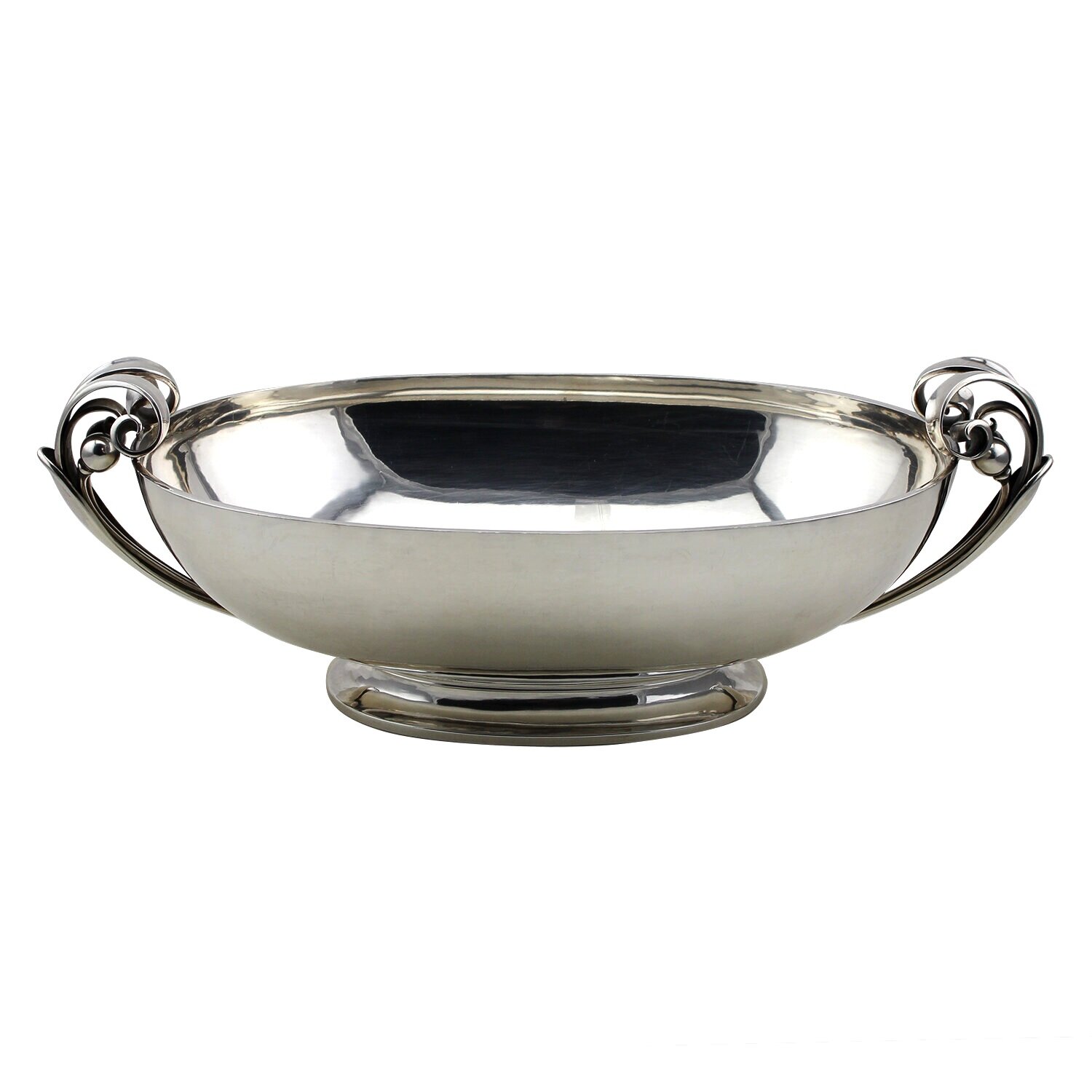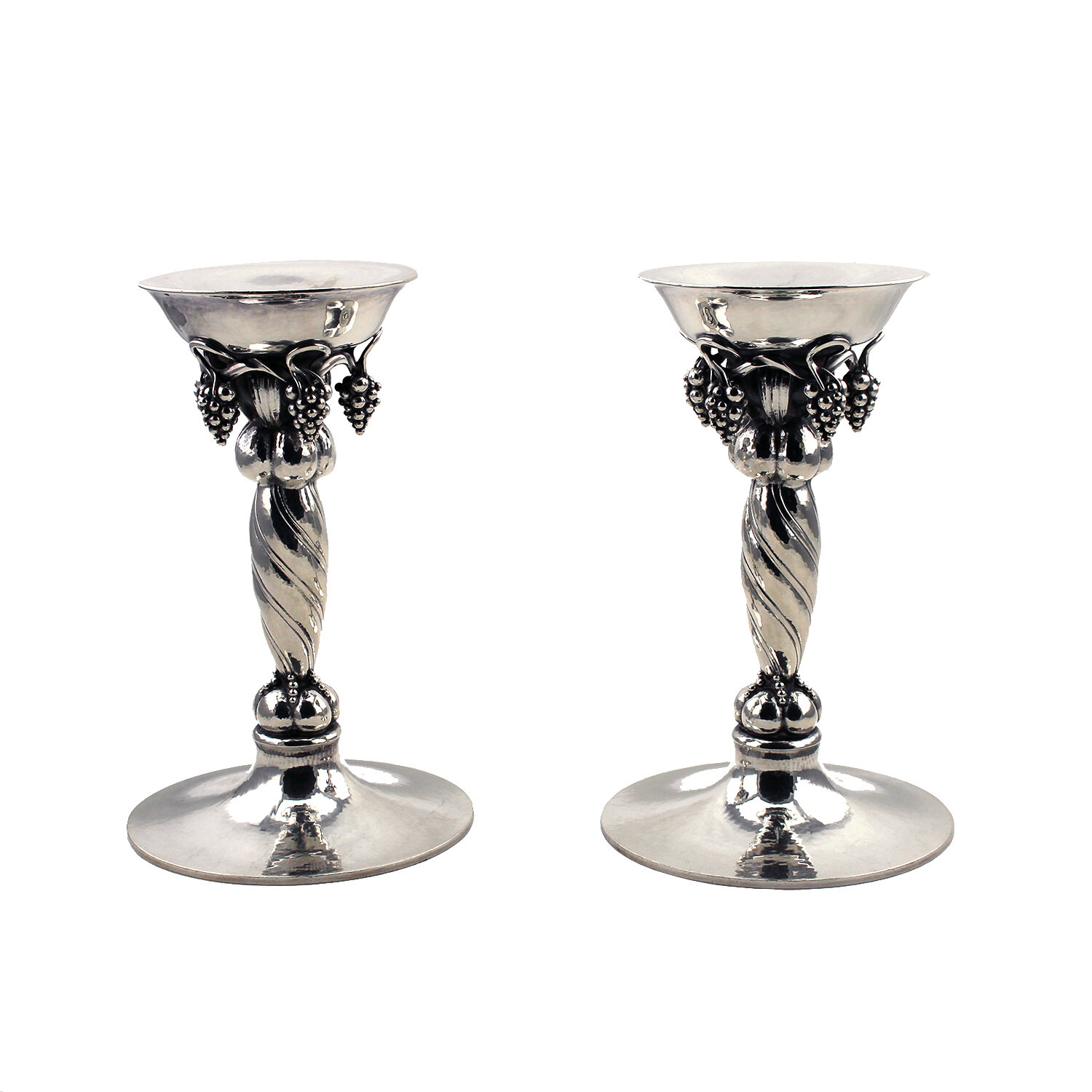GEORG JENSEN
Danish 1866-1935
AVAILABLE
Georg Jensen (Danish, 1866-1935)
Sterling Pitcher 432a
sterling silver pitcher 432A, designed by Johanne Rohde in 1920, bears impressed hallmarks to underside for maker (Dessin) Johanne Rohde, 925S, Sterling Denmark with Georg Jensen hallmark date 1933-44 and for Georg Jensen design 432A, inscribed "L.S.K.-E.B.A. 5-1-1941"
Size: 9 h x 5 ½ w x 4 d in
ZC20670
Georg Jensen (Danish, 1866-1935)
Sterling Silver Comport 235c
sterling silver comport 235C, designed by Georg Jensen, bears impressed hallmarks to underside Georg Jensen 925S Sterling Denmark, with Georg Jensen hallmark date circa 1917 and for Georg Jensen design 235C, inscribed "L.S.K.-E.B.a. 25-12 1940"
Size: 2 ¼ h x 3 w x 2 ½ d in
C20684
Georg Jensen (Danish, 1866-1935)
Sterling Tazza 263b
sterling silver grape tazza 263B, the spot-hammered bowl raised on a spiral fluted stem with circular foot, embellished with fruit-laden vines. Bears impressed hallmarks to underside 925S Denmark Sterling and for Georg Jensen design 263B, dated for 1933-44, inscribed "L.S.K.-E.B.K 27-6 1942"
The iconic Georg Jensen Grape Tazza was designed by Georg Jensen in 1918, and was made in 4 sizes of which this is the second.
Size: 7 ½ h x 7 ¼ w x 7 ¼ d in
ZC20669
Georg Jensen (Danish, 1866-1935)
Sterling Silver Comport 285a
sterling silver comport design 285A, designed by Georg Jensen, bears impressed hallmarks to underside 925S Denmark Sterling with Georg Jensen hallmark date 1933-44 and for Georg Jensen design 285A, inscribed "L.S.K.-E.B.K. 27-6 1943"
Size: 4 h x 5 w x 3 ½ d in
ZC20671
Georg Jensen (Danish, 1866-1935)
Georg Jensen sterling silver necklace with heart pendant on link chain, No 126 designed by Astrid Fog in the 1970's, with impressed marks "Georg Jensen 925s Denmark 126", post 1945, weight: 101 grams
Size: pendant 2 1/2 x 2 1/2 in; length with chain 18 in
C20574
Georg Jensen (Danish, 1866-1935)
Sterling Silver Ladle 141
sterling silver ladle or berry spoon 141, bears impressed hallmarks to underside Georg Jensen and for Georg Jensen design 141, Georg Jensen hallmark date circa 1912 and Sterling Denmark, inscribed "L.S.K.-E.B.K. 25-12 1941"
Size : 1 ½ h x 8 w x 2 ¼ d in
C20686
Georg Jensen (Danish, 1866-1935)
Sterling Silver Acorn Drink Spoons & Bottle Opener
sterling silver set of 8 drink spoons and bottle opener in Acorn pattern, with impressed hallmarks Sterling Denmark, Georg Jensen hallmark date 1933-44, with in fitted box, bottle opener with stainless steel opener, spoons each 7 1/4" long
C20687
Georg Jensen (Danish, 1866-1935)
Grape Tazza 263a
Sterling silver grape tazza, the spot-hammered bowl raised on a spiral fluted stem with circular foot, embellished with fruit-laden vines. Bears impressed hallmarks to underside for Georg Jensen design no. 263a, dated for 1945-77.
Size in inches: 5 h, 5 d
C20554
The iconic Georg Jensen Grape Tazza was designed by Georg Jensen in 1918, and was made in 4 sizes of which this is the smallest.
Georg Jensen (Danish, 1866-1935)
Pair of Grape Tazzas 263b
Pair of sterling silver grape tazzas, the spot-hammered bowl raised on a spiral fluted stem with circular foot, embellished with fruit-laden vines. Each bearing impressed hallmark to underside for Georg Jensen design no. 263B, both dated for 1945-77.
Size in inches: 7 1/2 h, 7 1/8 d
C20553
The iconic Georg Jensen Grape Tazza was designed by Georg Jensen in 1918, and was made in 4 sizes of which this is the second.
Georg Jensen (Danish, 1866-1935)
Georg Jensen Crystal and Silver Acorn Ice Bucket 1137
Cut glass spherical ice bucket with sterling silver Georg Jensen handle in the Acorn pattern, designed by Johan Rohde (1856-1935) in 1915. Bears impressed hallmark to handle hallmarked for Georg Jensen design 1137, with maker's mark for Johan Rohde, with date mark 1945-77. Crystal Ice Bucket designed by Hadeland of Norway.
C20333
sterling silver Georg Jensen combined letter opener and bookmark with finial in the shape of a fish, design #198 by Harald Nielsen. The blade is for opening letters, the long chain coming from the mouth of the fish, ending in a small charm, is a bookmark. Stamped Sterling Denmark, 198, George Jensen (post 1945).
Harald Nielsen (1892-1977) was Georg Jensen’s closest colleague and leading designer. His silver designs define classic Scandinavian style with ageless elegance that transcends time. The younger brother of Georg Jensen’s third wife, Harald Nielsen was drawn into the Georg Jensen silversmithy at the age of 17. He worked his way up to designer of the smithy school of apprentices, becoming director in 1954. His role was particularly important after Georg Jensen died in 1935 as Nielsen insured the continued high quality of the firm’s design by recruiting and training young designers according to Georg Jensen standards. He became artistic director of the company in 1958, a position he held until his retirement in 1962.
Size: 4.50 h x 0.63 w
C21200
Georg Jensen (Danish 1866-1935)
Sterling Silver Chandelier with Alabaster Shade
Extremely rare sterling silver holloware chandelier with alabaster shade, designed for Georg Jensen by Harald Nielsen. Date hallmarks for 1925-32, maker's mark for Harald Nielsen, with Swedish import marks. The chandelier features six light sockets and is suspended on three mounts on a central ring.
This chandelier is listed in the Georg Jensen archive in Copenhagen which also holds the original sketches. The chandelier has a rare alabaster shade, there is only one other chandelier listed in the archives incorporating alabaster. This stunning Georg Jensen chandelier was originally made for the Swedish market. Harald Nielsen was Georg Jensen’s closest colleague and leading designer. His silver designs define classic Scandinavian style with ageless elegance that transcends time. The younger brother of Georg Jensen’s third wife, Harald Nielsen was drawn into the Georg Jensen silversmithy at the age of 17. He worked his way up to designer of the smithy school of apprentices, becoming director in 1954. His role was particularly important after Georg Jensen died in 1935 as Nielsen insured the continued high quality of the firm’s design by recruiting and training young designers according to Georg Jensen standards. He became artistic director of the company in 1958, a position he held until his retirement in 1962.
Size: 18 h x 24 w x 24 d in
ZC19697
Georg Jensen (Danish 1866-1935)
133 Piece Cypress Pattern Sterling Flatware
Set of Cypress pattern sterling silver flatware, designed for Georg Jensen in 1953 by famed Norwegian designer Mathias Gerhard "Tias" Eckhoff.
Total of 133 pieces:
-9 dinner forks
-24 salad forks
-14 seafood forks
-10 dinner spoons
-10 teaspoons
-14 soup spoons
-14 bouillon spoons
-13 butter knives
-13 bread knives
-12 cheese knives
C19554
SELECT SOLD
Georg Jensen (Danish, 1866-1935)
Grape Tazza 264B
Large Georg Jensen sterling silver compote or tazza in the grape pattern, the spreading circular base rising to a spiral fluted stem surmounted by fruit-laden vines, surmounted by a large spot-hammered bowl with flaring rim. Bears impressed hallmarks to underside Denmark Georg Jensen Sterling and for Georg Jensen design 264B, with date mark post 1945.
The iconic Georg Jensen Grape Tazza was designed by Georg Jensen in 1918, and was made in 4 sizes of which this is the largest and most impressive.
Size 12" high x 11 7/8" diameter
C20938
SOLD
This item is no longer available. Please contact us to inquire about similar pieces.
uno@langmann.com
604 736 8825 or 1 800 730 8825
Georg Jensen (Danish, 1866-1935)
Set of Bernadotte Flatware
57 piece set of sterling silver art deco flatware in the Bernadotte pattern, designed by Sigvard Bernadotte (1907-2002) in 1939.
Impressed hallmark to each for Georg Jensen and date mark for 1945-77
ZC20717
SOLD
This item is no longer available. Please contact us to inquire about similar pieces.
uno@langmann.com
604 736 8825 or 1 800 730 8825
Georg Jensen (Danish 1866-1935)
Sterling Silver Pitcher 432A
Sterling silver pitcher by Johan Rohde for Georg Jensen, design number 432A; entirely hand wrought and hand hammered, date mark for 1945 to present, maker's mark for Johan Rohde and Georg Jensen. In the early years of Jensen silversmithy, the two key designers were Georg Jensen and Johan Rohde. Jensen’s patterns emphasized decoration and exuberant ornamental forms while Rohde focused his designs on clean lines and simplified forms. This pitcher 432A is possibly the most famous design by Rohde and the most well-known pitcher design for the Georg Jensen silver company. Designed in 1920, the form was considered too modern by Jensen and they withheld production of the pattern until 1925. It has since become an icon of twentieth century design and can be found in museum collections worldwide.
Example on page 57 “Georg Jensen Holloware The Silver Fund Collection” by David Taylor and Jason W. Laskey and on p. 242 in the book "Georg Jensen, A Tradition of Splendid Silver" by Janet Drucker.
Size: 9 ¼ h x 4 w x 5 ¼ d in
C19968
SOLD
This item is no longer available, please contact us to inquire about similar pieces.
604 736 8825 or 1 800 730 8825
Georg Jensen (Danish 1866-1935)
Hammered Silver Centerpiece Design Number 196
impressive hammered silver centerpiece designed b Johan Rohde for Georg Jensen, circa 1916. The bowl rests on an openwork stem with leaves, clusters and beads and a circular foot. Stamped with design number 196, silver stamp for 830 silver, Swedish import stamps, with 'Georg Jensen' and 'Copenhagen' marks dated to 1915-27
Size: 8 ¾ h x 10 ⅛ dia in
C19446
SOLD
This item is no longer available, please contact us to inquire about similar pieces.
604 736 8825 or 1 800 730 8825
Georg Jensen (Danish 1866-1935)
Cosmos 3 Piece Coffee Service
Johan Rohde for Georg Jensen. 'Cosmos' coffee service in light hammered sterling silver, embellished with fluting and stylized foliage, handle in fluted ebony. Consisting of: coffee pot (H. 9.25".), sugar bowl with lid (H.4.25"), cream pitcher (H. 4.25"). Produced by Georg Jensen in the period 1915-1933. Design No. 45
Literature: 'Georg Jensen, A Tradition of Splendid Silver', reproduced and discussed p. 222.
C19478
SOLD
This item is no longer available, please contact us to inquire about similar pieces.
604 736 8825 or 1 800 730 8825
Georg Jensen (Danish 1866-1935)
Pyramid Pattern 36 Piece Sterling Flatware Set
set of 36 pieces of Pyramid Pattern Georg Jensen sterling silver flatware, stamped "Sterling Denmark" and with the date stamp post 1945, in original fitted boxes, including:-6 table knives with stainless steel blades-6 entree forks-6 dessert/cake forks-6 tablespoons-12 teaspoons
ZC19654
SOLD
This item is no longer available, please contact us to inquire about similar pieces.604 736 8825 or 1 800 730 8825
Georg Jensen (Danish 1866-1935)
Georg Jensen Oval Centrepiece Bowl, #622b
Danish sterling silver oval centrepiece bowl #622B, on pedestal foot, with two upswept scroll and berry handles, #622B, made by Harald Nielsen for Georg Jensen. Hallmarked for Harald Nielsen, 1945-77. Size: 16 ½ w in
C19781
SOLD
This item is no longer available, please contact us to inquire about similar pieces.
604 736 8825 or 1 800 730 8825
Georg Jensen (Danish 1866-1935)
Pair of Grape Pattern Sterling Silver Candlesticks, Number 263 BThis pair weighs approximately 54.7 troy ounces and they are the large size, designed in 1930
Size: 8 x 5 ⅛ in
C19553
SOLD
This item is no longer available, please contact us to inquire about similar pieces.
604 736 8825 or 1 800 730 8825
Georg Arthur Jensen was born on August 31st, 1866 in Rådvad, Denmark, just north of Copenhagen. His father was a knife grinder and worked in a knife factory. Jensen worked with his father at this factory from an early age, receiving little schooling. In his youth, he showed a keen interest in the arts and at the age of fourteen his family moved to Copenhagen where he began his apprenticeship as a goldsmith at the firm Guldsmed Andersen. He attended a technical school on Sundays for additional training. In his spare time, Jensen modelled clay, having long wanted to become a sculptor.
Jensen ended his apprenticeship in 1884, and began pursuing a career in sculpting. He studied at the Royal Academy of Fine Arts as a sculpture student, graduating in 1892 at the age of 25. His work was well received, and one of his pieces, The Harvested, was exhibited at the Charlottenborg annual exhibition in 1883.
In 1891, Jensen married Marie Christine Antonette Wulff, and had two children. Antonette died suddenly from kidney disease in 1897. It was a challenging period for Jensen both personally and professionally, as it was difficult making a living as a sculptor. He turned his attention back to the applied arts, working as a modeller at the Bing & Grøndahl porcelain factory. In 1898, Jensen founded a small pottery workshop in partnership with his personal friend and painter, Christian Petersen. In 1904, Jensen opened his own small silversmithy in Copenhagen.
Jensen was given a travel grant by the Danish Academy and spent two years touring the art centers of France and Italy. This exposed him to the Art Nouveau style which greatly influenced his work and developed his ambition to fuse beauty and function into his creations. Jensen exhibited his silverwork for the first time in the fall of 1904 at the Museum of Decorative Art in Copenhagen. The exhibition was an immediate success and helped launch his business.
In the early years of his business, Jensen primarily produced jewelry with the intention of creating affordable art for the middle classes, while emphasizing the value of handmade craftsmanship over mass produced goods. Jensen also collaborated with other artists such as the Danish artist Christian Mohl Hansen. Together they produced the dove brooch which became a motif in many of his jewelry pieces. The design endures to this day. Jensen began creating hollowware, such as a teapot with the now familiar “Magnolia” design. Around this time, Georg Jensen remarried Maren Pedersen, his housekeeper who was pregnant with his child.
In 1905, Jensen began what was to become one of his most important collaborations with Johan Rohde. Rohde’s approach to design was cautious and methodical which complimented Jensen’s more romantic and impulsive approach. In 1916, Rohde designed the most famous of Jensen’s flatware patters, ACORN.
His second wife’s health declined over many years and in 1907, she passed away of tuberculosis. Jensen fell in love again that year to Johanne Nielsen, and married her within the year’s end. Jensen’s workshop gained a reputation for having a friendly, democratic atmosphere that was conducive to collaboration and a feeling of solidarity among the staff. His sales steadily grew and often his pieces would sell out. Eventually, Johanne’s family became involved and helped with bookkeeping, sales, photography, and even apprenticing in the workshop. Jensen sold shares of his firm to support its expansion. The success of his business life was unfortunately overshadowed by the death of his third wife from Spanish Influenza in 1918.
Retail outlets continued to expand through Europe, with Berlin in 1909 and another in Paris shortly after World War I. By 1921 he had a location in London and then in 1925 in Barcelona. He continued to expand throughout Europe and by 1935 to the US. Jensen’s reputation in the US was propelled by his solo exhibition at the Art Institute of Chicago in 1921, which was accompanied by an English language book. This led to the opening of a shop in the US, and the American marked loved his sophisticated, simple yet decorative pieces so much that they were in great demand and often sold out. The company continued to thrive, and by the end of the 1920s, Jensen had retail outlets in New York, London, Paris, Stockholm, and Berlin.
The last decade of Jensen’s life was lined with professional accolades. He was awarded the Grand Prix at the Paris World’s Fair in 1925, the 1929 World’s Fair in Barcelona, and again in 1935 at the World’s Fair in Brussels. He was the only silversmith outside Great Britain to exhibit at the Goldsmith’s Hall in 1932. Georg Jensen passed away in 1935 at the age of 69.





















